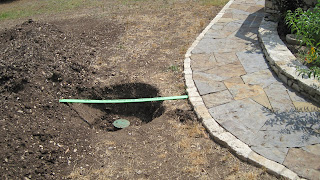Once all the rock from the Extended South Pit was removed, we could fill it back up with dirt.
This took all the dirt that we had been stockpiling in the backyard. Three full days of nothing but moving dirt from the pile in the backyard and dumping it into the pit.
We next needed to re-install irrigation in this bed. As with the North Bed, we are planning to use underground drip irrigation. Back in November, we ran a supply line from the controller for Zone 3 to both the North and South beds. The first problem was to find that supply line. Not being smart enough to mark where it was exactly, we approximated and dug.
Nothing. Luckily we hit solid rock at 22 inches down, so we didn't keep digging in the wrong spot. To get a better idea, we looked at the one photo that we had of the supply line to the South bed, and used a hose to try to recreate the image of the supply line.
This time, at 20 inches down, we found the supply line.
It was a bit longer than necessary, so we cut it off, and put a box over it.
We attached a cut-off valve, and then the filter, and 30-pound pressure regulator needed for underground drip irrigation.
We laid out a plan of how to put in the drip irrigation lines. The greenhouse effectively splits the South bed into a left and right (or East and West) sides. For each of these we need to give special attention to the trees.
We had to go back out in the dirt that we had just put in the pit, and trench it to about 4 to 6 inches deep. Our plan was to put the drip irrigation lines at 4 inches down, and then add an additional 2 inches of good dirt over the top. We trenched both the left and right (and front and back) of the greenhouse, and installed our drip irrigation lines.
The supply line is 1/2 inch PVC. The drip lines connect directly to these two lines -- one left and one right. We have a collection line at the other end which leads to a flush valve. In this case, we have 3 flush valves -- one in each corner and one in the middle for the right side (West) PVC supply line.
For the North bed, the collection line was another 1/2 PVC. But for the South Bed, we decided to use the drip line itself. This should provide somewhat more drip area.
Unfortunately, it seems that the valve controlling Zone 3 is not working correctly -- we can't get any real water out of it, not even enough to flush the lines. So tomorrow we have arranged for American Irrigation Repair to come out and replace the valve for Zone 3. Also the valve for Zone 4 that seems to have stopped working last year. Then we will be able to flush the lines, test how well the drip works, and then bury everything.
The parts for the drip irrigation, including the low-flow regulator, filter, dripline, and all the connectors was $252.71to John Deere Landscapes plus $16.83 to Lowe's (for the connector box) and $73.84 to Home Depot (for the PVC parts).


























